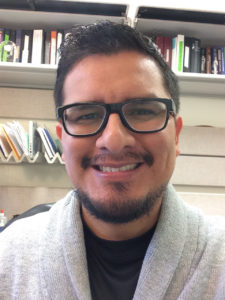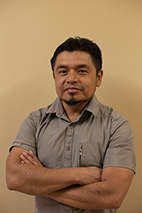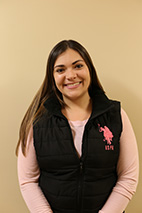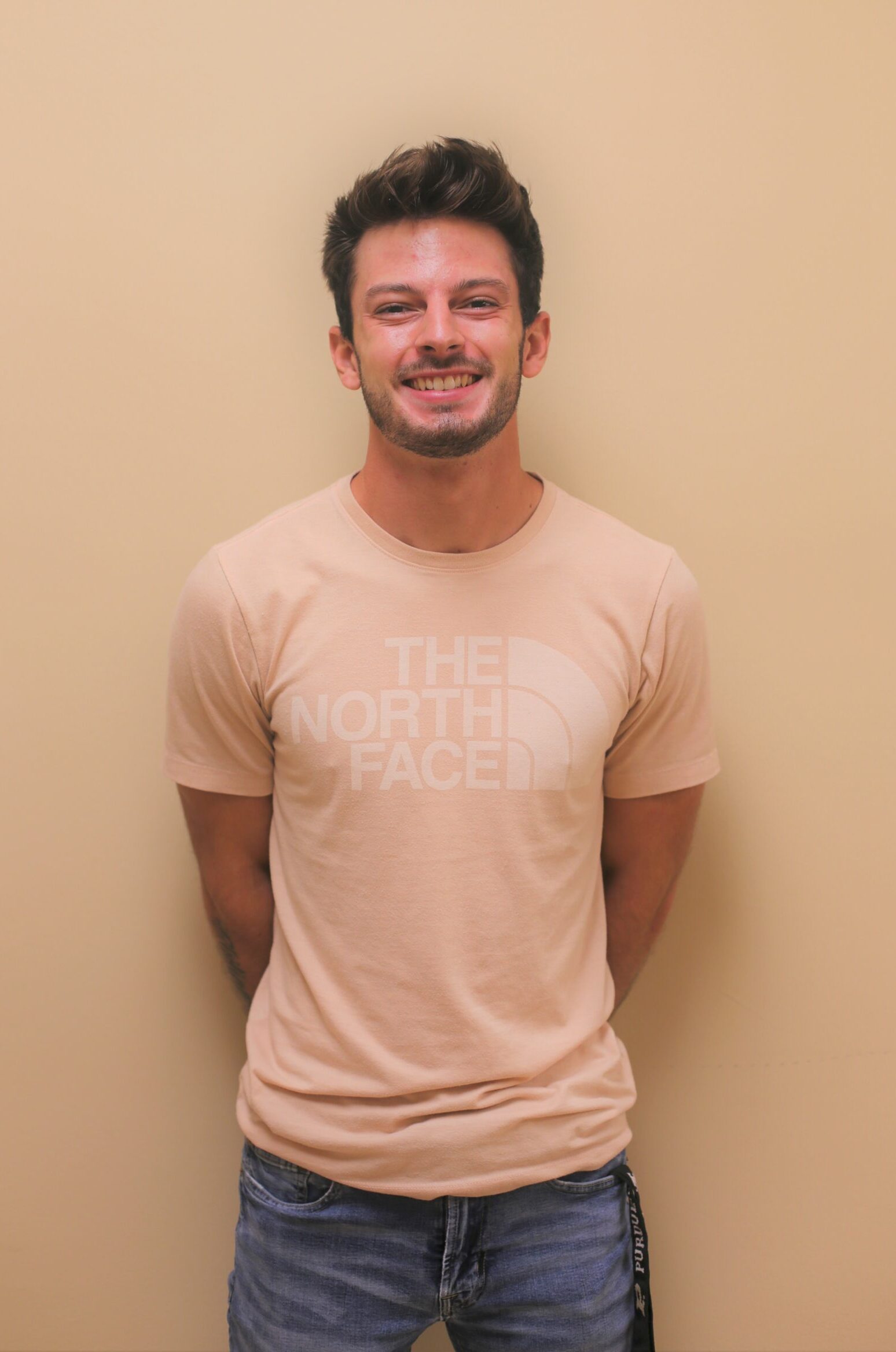PI & Objective Leaders

Dr. C. D. Cruz
Dr. Cruz is an Assistant Professor, and his interdisciplinary research focuses on the integration of fungal biology, ecology, and epidemiology for plant disease management. His specialties include plant pathology, crop protection, risk assessment, disease resistance, ecology, epidemiology, phenomics, and remote sensing applications.
Contact Information
Department of Botany & Plant Pathology, Purdue University
915 W State St., West Lafayette, IN 47907, USA
Dr. Cruz is an Assistant Professor, and his interdisciplinary research focuses on the integration of fungal biology, ecology, and epidemiology for plant disease management. His specialties include plant pathology, crop protection, risk assessment, disease resistance, ecology, epidemiology, phenomics, and remote sensing applications.
Education
- Ph.D., 2013 – Kansas State University, Plant Pathology
- M.Sc., 2008 – Kansas State University, Plant Pathology
- B.Sc., 2002 – Zamorano Pan-American Agricultural University
Professional Experience
- Assistant Professor, 2018-Present – Purdue University
- Research Assistant Professor, 2016-2017 – Kansas State University
- Postdoctoral Research Associate, 2013-2015 – Kansas State University
- Liaison Coordinator (Wheat Blast Project, South America), 2011-Present
- Technical Sales Representative (Agro-chemical), 2002-2005 – Corporación Custer
Professional Societies and Working Groups
- American Phytopathological Society (APS), 2007-present
- APS Spectroscopy Working Group, 2018-present
- APS Epidemiology Committee, 2017-present
- APS Emerging Diseases and Pathogens Committee, 2018-present
- CIMMYT International Wheat Improvement Network, 2017-present
- North American Plant Phenotyping Network, 2017-present
- Wheat Blast Research Group, 2009-present
- APS Tropical Plant Pathology Committee, 2008
Courses taught at Purdue University
- BTNY 535, Plant Disease Management, three-credit-hour course. An introduction to the study of the dynamics of plant diseases, and the epidemiological basis of disease management strategies. Plant Disease Management is an upper-level course and intended for students who have an interest in plant pathology, agronomy, or closely related areas. Each topic will be covered on a lecture/discussion format.
- Course goal: Understand how plant disease epidemics occur and how they are monitored and managed.
- Course outcome: Explain how epidemiology is used to evaluate plant disease management options.
BIOGRAPHY
Throughout my life and career, a recurring theme has guided me: a deep curiosity for understanding the challenges people face and a passion for using science to help solve them. As a classically trained plant pathologist, I’ve remained committed to applying rigorous research and data-driven innovation to real-world agricultural problems. This commitment has taken me across borders, disciplines, and collaborations, enriching both my scientific work and personal growth.
My early years were marked by movement across countries, shaped by my parents' decisions during times of transition. I was five when we left our home behind, journeying for seven days across rugged highlands in a modest car with limited horsepower but unlimited purpose. That journey—filled with awe-inspiring landscapes, unfamiliar foods, and glimpses into others’ ways of life—left a lasting impression. It was the first time I began to understand how environments and circumstances shape people's realities, and how meaningful it is to listen, observe, and learn from those experiences. I didn’t know it at the time, but that experience planted the seeds of empathy, observation, and wonder that continue to guide me today.
I was fortunate to receive an excellent education, thanks to the dedication of my family, mentors, and institutions that believed in me. My elementary school and high school teachers inspired me to dream beyond the horizon. At 17, I learned about a rigorous agricultural university known for hands-on training and academic excellence. After earning admission and piecing together a patchwork of financial support, I began a transformative chapter that would lead me into agronomy and later, plant pathology.
Upon graduation, I worked as a Technical Representative for the agrochemical division of a multinational company. During field visits, I witnessed growers confronting destructive plant diseases with limited tools. One visit stands out: a conversation with a producer who turned out to be a scientist and a well-respected local leader, who introduced me to predictive models that could help optimize fungicide use. I remember being transfixed by disease curves on his computer screen—data that told a story, revealed a pattern, and offered a way forward. That moment turned into a calling.
Soon after, I joined The Ohio State University as a Visiting Scholar, followed by a master’s program under the guidance of Dr. Anne Dorrance. There, I also had the privilege to learn from Dr. Laurence V. Madden, a pioneer and world renowned expert in disease epidemiology, and Dr. Pierce Paul, whose expertise in quantitative tools and modeling deepened my understanding of data-informed decision-making.
For my Ph.D., I worked under the mentorship of Professors James P. Stack and William (Bill) Bockus, and Distinguished Professor Barbara Valent. Under their guidance, I became a member of a multi-national research initiative focused on a high-consequence disease affecting wheat. As Liaison Coordinator and lead scientist, I worked across teams in the U.S. and abroad, building bridges between researchers, stakeholders, and growers. A major milestone was our identification of a genetic resistance factor that has since influenced breeding programs globally.
In 2018, I joined Purdue University, where I now serve as an Associate Professor. My work centers on emerging plant diseases and the development of disease measurement systems and predictive tools. I collaborate with colleagues in plant pathology, data science, engineering, and policy to better understand the dynamics of crop diseases and to co-create actionable solutions for stakeholders.
Studying high-consequence diseases that pose a potential threat to U.S. agriculture requires a proactive and collaborative approach. By engaging with the scientific community and supporting stakeholders where these diseases originate, we can better understand, manage, and reduce their risks before they escalate. This philosophy underpins my work across multiple pathosystems, including wheat blast and tar spot. Helping stakeholders worldwide strengthens our collective capacity to understand and manage plant health risks. This proactive engagement contributes to both local and global awareness and preparedness, and supports efforts to manage ongoing and emerging challenges more effectively. I view collaboration not just as a strategic advantage, but as a scientific responsibility.
I remain deeply committed to mentorship and capacity building. Through programs such as the Borlaug International Agricultural Science and Technology Fellowship and USDA-supported initiatives in the United States, I’ve had the opportunity to train students and early-career scientists, including those from rural and local communities as well as international institutions. Supporting these individuals is critical to building resilient agricultural systems and expanding access to knowledge. Many now lead impactful work in their institutions and communities.
I also serve in leadership roles with professional organizations, including the American Phytopathological Society, and contribute to national working groups on crop disease management. At Purdue, I’m part of the Executive Committee of the Institute for Digital and Advanced Agricultural Systems, which seeks to integrate modern technologies into agricultural research and practice.
Looking back, I see how my journey through different regions and life circumstances has shaped a deep sense of adaptability and empathy. From early relocations to working across borders, these formative experiences taught me to value a range of perspectives and to stay grounded in resilience. They continue to influence how I support students and collaborate with researchers, guiding my approach with openness, curiosity, and care.
Whether I’m leading a research project, mentoring a student, or designing a new tool for disease measurement and forecasting, I try to hold on to the curiosity and compassion that started this journey. For me, plant pathology is not just a scientific discipline—it’s a lens through which I see the interconnectedness of people, crops, environments, and futures. And that makes the work not only meaningful but also deeply personal.

Dr. Carlos Gongora-Canul
His research focuses on plant disease epidemiology in corn and wheat by using quantitative epidemiology, plant-sensing technology and digital plant phenomics. His Research explores the use of emerging technologies including high-throughput phenotyping to detect, quantify, and predict plant diseases.
Contact Information
Department of Botany & Plant Pathology
Purdue University
915 W State St., West Lafayette, IN 47907, USA
His research focuses on plant disease epidemiology in corn and wheat diseases by using quantitative epidemiology, plant-sensing technology and digital plant phenomics. His research explores the use of emerging technologies, including high-throughput phenotyping to detect, quantify, and predict plant diseases.
Research Interest
- Quantitative plant disease epidemiology
- Plant disease digital phenomics
- Plant pathology/plant breeding research interaction
Education and Training
- PhD.: Plant Pathology, Epidemiology and Statistics, Iowa State University. 2010. Ames, IA, USA
- Master: Plant Pathology and Plant Disease Epidemiology. Colegio de Postgraduados 2014 Montecillo, Mex.
- Bachelor: Agronomist in Plant Parasitology, Chapingo Autonomous University.2000. Chapingo, Mex.
Professional Experience
- Research & Development General Manager-Plant Breeding of Jatropha curcas for Biodiesel production. Jatronergy-Lodemo Petroleum Corporation). 2013-2018. Merida, Mex.
- Senior Research Associate (Trait Integration/Corn Breeding-Program Lead-Latin America North-LAN). Introgresion of GMO and Native Genes into inbreds and Hybrids. Pioneer Hi-Bred International (Corteva-DowDupont). 2010-2013, Guadalajara, Mex.
- Research Associate. Corn Breeding. Pioneer Hi-Bred International (Corteva-DowDupont). 2005-2006. Guadalajara, Mex.
- Invited Professor of Graduate Program of Plant Breeding and Plant Pathology (MSc and PhD). Centro de Investigación y Asistencia Tecnológica del Estado de Jalisco, (CIATEJ). 2016-2017. Mérida, Mex.
- Invited Professor of Statistics and Mathematics. Anahuac Mayab University. January 2015-2017. Mérida, Mex.
- Owner of “Maya Corn Harvest”. A Corn Hybrid Seed Starting Up Company. Campeche, Mex. 2014 to date.
- Mexican International Agriculture Inspection Service. Mexico Department of Agriculture. SAGARPA-SENASICA-DGIF. 2001- 2002. Cancun, Mex.
Developed products
- Jatropha curcas: development of many inbreds and commercial hybrids: ALC01®, ALJCH01®, ALJCH02®, ALJCH03®
- Corn: development of Inbreds and commercial hybrids
- Patent: Method for generating stable haploids of jatropha curcas (WO2017111574A1-PCT/MX2016/050022)
Peer-Reviewed Publications
- Herrera-Cool, G. J., López-Puc, G., Joã Loureiro, Rodríguez Buenfil, I. M., Iglesias-Andreu, L. G., Uc-Varguez, A., Aguilera-Cauich, E. A., Góngora-Canul, C., and Martinez-Sebastian, G. 2018. Organogenesis and estimation of nuclear DNA content in eight generation of Jatropha curcas L. subcultured in vitro. Scientia Horticulturae (In revision)
- Góngora-Canul, C., Aguilera-Cauich, E. A, Martinez-Sebastian, G., López-Puc G., Uc-Varguez, A., and Pérez-Hernandez, O. 2018. Spatio-Temporal Dynamics of Mealybug (Hemiptera: Pseudococcidae) Populations in Plantations of Jatropha curcas L. in Yucatán, Mex.. Industrial Crops and Products 117: 110-117.
- Góngora-Canul, C., Aguilera-Cauich, E. A., and Martinez-Sebastian, G. 2017. Assessment of the flowering biology of the novel "female only flower" trait in Jatropha curcas L. J. Plant Breed. Crop Sci. 9:208-216.
- Uc-Varguez, A., López-Puc G., Góngora-Canul, C., Martinez-Sebastian, G., and Aguilera-Cauich, E. A. 2017. Spatio-temporal behavior of foot rot (Lasiodiplodia theobromae) in Jatropha curcas L. plantations in Yucatan, Mexico. Eu .J. Plant Pathol. 150: 991-1000.
- Aguilera-Cauich, E. A., Pérez-Brito, D., Navarrete Y. A., López-Puc, G., Castañón N., G., Sacramento, R. J., Rubio, A. C., Uc-Várguez, A., Góngora-Canul, C. and, Mijangos-Cortes, J. O. 2015. Assessment of phenotypic diversity and agronomic contrast in American accessions of Jatropha curcas Industrial Crops and Products 77: 1001-1003.
- A. Ferreira, T. C. Harrington, C. C. Gongora-Canul, R. G. Mafia, E. A. V.Zauza, A. C. Alfenas. 2012. Spatial-temporal patterns of Ceratocystis wilt in eucalyptus plantations in Brazil. Forest Pathology 43: 153-164.
- Gongora-Canul, C., Nutter, F. W. Jr., and Leandro, L. F. S. 2011. Temporal dynamics of root and foliar symptoms of soybean sudden death syndrome. Eur. J. Plant Pathol: 132:71-79.
- Gongora-Canul, C. C., and Leandro, L. F. S. 2011. Plant age affects root infection and development of foliar symptoms of soybean sudden death syndrome. Plant Disease 95: 242-247.
- Gongora-Canul, C. C., and Leandro, L. F. S. 2011. Effect of soil temperature and plant age at time of inoculation on progress of root rot and foliar symptoms of soybean sudden death syndrome. Plant Disease 95:436-440.
- Silva-Rojas, H. V., Fernández-Pavía, S. P., Gongora-Canul, C., and Ávila-Quezada, G. D. 2009. Spatial-temporal distribution of pepper wilt (Capsicum annum L.) in Chihuahua and identification of the causal agent Phytophthora capsici Leo. Revista Mexicana de Fitopatología 27:134-147.
- Ruiz-García, N., Mora-Aguilera, G. Rivas-Valencia, P., Gongora-Canul, C., Loeza-Kuk, E. Ochoa-Martínez, D., Ramírez-Valverde, G., Gutierrez-Espinosa, M. A., and Álvarez-Ramos, R. 2009. Reliability of direct tissue BLOT-ELISA and DAS-ELISA in the detection of citrus tristeza virus and sampling in commercial plots of Tamaulipas Mex.. Revista Chapingo Serie Horticultura 15:41-47.
- Góngora-Canul, C., Escamilla-Bencomo, J. Pérez-Hernández, O. and Mora-Aguilera, G., 2004. Spread gradients of lethal yellowing of coconut (Cocos nucifera L.) in Sisal Yucatán, Mex.. Revista Mexicana de Fitopatología 22:370-376.
- Pérez-Hernández, O., Gongora-Canul, C., Medina-Lara, F. M., Oropeza-Salím, C., Escamilla-Bencomo, J. A, and Mora-Aguilera, G. 2004. Spatio-temporal pattern of lethal yellowing of coconut (Cocos nicifera L.) in Yucatán, Mex.. Revista Mexicana de Fitopatología 22:231-238.
Books and Chapters
- Uc-Varguez, A., Góngora-Canul, C., López-Puc G., Martinez-Sebastian, G., and Aguilera-Cauich, E. A. 2017. Management of pest and diseases Jatropha curcas L. crop in Southern Mexico. 53 p. Hojarasca, Mexico, DF. ISBN: 978-607-97894-1-1.
- Góngora-Canul, C., Martinez-Sebastian, G., Uc-Varguez, A and López-Puc G. 2018. The Jatropha curcas L. crop in Southern Mexico. 66 p. CIATEJ, Mex.. ISBN 978-607-97894-5-9.
- Gongora-Canul C. C., and Martinez-Sebastian, G.2018. Advances in Jatropha curcas L. breeding: Experiences of Jatronergy Company: eight years. Pp. 79-94. In: Jatropha curcas L. in Mexico: Advances and Perspectives of a Biofuel Crop. Lopez Puc, G. and Uc Varguez, A. (Eds). 264 p. Corporativo Inteliplan SA DE CV, Yucatán, Mexico. ISBN 978-607-98348-2-1.
- Gongora-Canul C. C., and Uc-Varguez, A. 2018. Pest and diseases in Jatropha curcas L. crop in Mexico. Pp. 123-146. In: Advances and Perspectives of a Biofuel Crop. Lopez Puc, G. and Uc Varguez, A. (Eds). 264 p. Corporativo Inteliplan SA DE CV, Yucatán, Mexico. ISBN 978-607-98348-2-1.
- Gongora-Canul C. C., and Uc-Varguez, A. 2018. Production and management of Jatropha curcas L. crop in Yucatan, Mexico. Pp. 95-122. In: Advances and Perspectives of a Biofuel Crop. Lopez Puc, G. and Uc Varguez, A. (Eds). 264 p. Corporativo Inteliplan SA DE CV, Yucatán, Mexico. ISBN 978-607-98348-2-1.
- Gongora-Canul C. 2017. Opportunities in Mex.: Biofuels. Biofuel International 11: 40. Woodcote Media Ltd, UK. ISSN 1754-2170
- Gongora-Canul C. C. 2015. Jatropha curcas Varieties and its potential to produce Biofuel. Pp. 29-30. In: 1St International Congress of Jatropha curcas L. September 2015, Cuernavaca, Morelos Mexico. 39 p.
- Gongora-Canul C. C. 2015. Breeding of Jatropha curcas. P. 7-11. In: Gaceta SIIDETEY 6:(52). April 2015, Mérida, Yucatán, Mexico. 27 p.
Awards
- Member of National Researcher System-National Council of Science and Technology (CONACYT)- SNI-Level I (63541) (2014-2017).

Andres Cruz
Andres is the Laboratory Technician for Dr. Cruz’s lab. His work focuses in setting up, operating, and maintaining the lab equipment. He tests, monitors, and keeps detailed logs of the experiments as well as supporting researchers with their work. Andres is a certified UAV flight operator and is in charge of conducting flights, maintaining equipment and data logging. He also is in charge of producing media for manuscripts, website, and presentation publications for the lab.
Contact Information
Department of Botany & Plant Pathology
Purdue University
915 W State St., West Lafayette, IN 47907, USA
Andres is the Laboratory Technician for Dr. Cruz’s lab. His work focuses in setting up, operating, and maintaining the lab equipment. He tests, monitors, and keeps detailed logs of the experiments as well as supporting researchers with their work. Andres is a certified UAV flight operator and is in charge of conducting flights, maintaining equipment and data logging. He also is in charge of producing media for manuscripts, website, and presentation publications for the lab.
Job Experience
12/2016 | Kansas State University Department of Plant Pathology
Research Technician
Created flight plans and flew Unmanned Aerial Systems (UASs) on several research experiments in multiple locations in Bolivia to study the epidemiology of Magnaporthe oryzae Triticum (MoT). Maintained a record of multispectral information to be processed in collaboration with remote sensing experts at Kansas State University. Took photographs and videos with a 4K RGB camera mounted on a UAS and with a regular DSLR camera to build an imagery collection of wheat blast symptoms; photos and videos were used on K-State Wheat Blast social media accounts and will be used on future research publications. Prepared media for the growth of MoT inside a biosafety-level-3 facility (Biosecurity Research Institute) and followed standard operating procedures for decontamination and disposal of hazardous waste and other materials. Oversaw the making and maintenance of a seed inventory for the use of our collaborators in the United States and Bolivia.
06/2016-12/2016 | Kansas State University Department of Plant Pathology
Research Consultant (Bolivia)
Helped with evaluations of multiple laboratory, greenhouse and field experiments in Bolivia. These experiments were aimed at identifying new sources of blast resistance and understanding the ecology and epidemiology of wheat blast. Duties included assisting scientists with data collection through visual and remote sensing techniques, as well as with data storage. Helped generating content for a wheat blast website.
01/2014-04/2014 | Kansas State University Department of Plant Pathology
Research Consultant (Bolivia)
Helped in a scientific study of the fungal pathogen Magnaporthe oryzae Triticum that seriously affects wheat production in Bolivia. Helped identify the pathogen on affected plants in the field and rate disease severity and incidence on disease nurseries. Collected field samples shipped to a BSL-3 laboratory in Kansas. Experiments were aimed at understanding the ecology and epidemiology of the wheat blast pathogen and identifying sources of resistance.
2009 – 2014 Ohio Agricultural Research and Development
(June-August) Center (OARDC)-The Ohio State University
Student Research Aid-Non OSU
Helped with planting and harvesting of vegetables and legumes at Drs. Sally Miller and Anne Dorrance labs. Prepared media for pathogen growth. Helped with pesticide applications in the greenhouse and in the field. Helped researchers in general labors prior to the identification of new resistance genes of three fungal pathogens on soybean plants. Helped preparing specimens and samples prior to the identification and discovery of new races of fungal pathogens and new species of parasitic nematodes of soybean plants. Designed and implemented three hydroponic systems.
Research training and Certificates
2019
Phenome 2019, Tucson, Arizona
The 3rd annual Phenome 2019 conference represents a multidisciplinary community comprising plant biologists, ecologists, engineers, agronomists, computational scientists, and representatives from U.S. federal agencies who come together in a rich and diverse networking environment to foster collaboration, innovation, and the initiation of multi-investigator and multi-institution projects. Workshops and field trips allow participants to experience some of the exciting new hands-on applications available in the phenomics space, and to observe emerging technologies in action.
2017
Maricopa Field-Based High Throughput Phenotyping Workshop, Maricopa, Arizona
Four-day, hands-on training workshop to provide opportunities for participants to acquire a foundation in principles of Field Based High Throughput Phenotyping. Instructors from USDA-ARS, University of Arizona, and more will provide participants comprehensive exposure to field phenomics in action
2017
Kansas State University Polytechnic Campus
2310 Centennial Road, Salina, KS 67401-8196
sUAS Commercial Pilot Training (Certificate)
Kansas State University Polytechnic Campus
2310 Centennial Road, Salina, KS 67401-8196
Unmanned Aircraft Systems: Data and Image Processing
Kansas State University Biosecurity Research Institute
1041 Pat Roberts Hall, Manhattan, KS 66506
Fire Safety Training (Certificate)
Chemical Hygiene Lab Safety Training (Certificate)
Security Orientation Training (Researcher) (Certificate)
Cyber & Information Security Awareness Training (Certificate)
BRI (Non-SRA) High-Containment Refresher Training (Certificate)
Annual Hands-on Training (Certificate)
2015
Universidad San Francisco de Quito
Diego de Robles S/N y Vía, Interoceánica Cumbayá, Ecuador Research excursions and cultural visits to the Tiputini Biodiversity Research Station. The Tiputini Biodiversity Station is a biological field station established in the Amazon, located within the world’s greatest biodiversity hotspot and one of the planet’s last wilderness areas. https://www.youtube.com/watch?v=FChrJlmpOQY
2012
EARTH University
Guácimo, Costa Rica
EARTH University is located in the heart of a tropical rainforest in Costa Rica. This university focuses on teaching sustainable agricultural practices to preserve species and the environment. Went on trips outside the university to see and learn about natural aquifers and how to preserve them. In charge of planning and developing a project where I used sustainable methods to fertilize organic lettuce. Designed a sensorial garden with sustainable materials that could be used and built inside the University
Extracurricular and volunteer activities
2015
Ministry of the Environment, Calle Madrid, 1159 y Andalucía, Quito-Ecuador
Helped with maintenance and reforestation of 1,600 hectares of public and private lands in a period of two months. Species planted included Tamarindus indica L., and Prosopis juliflora (Sw.) DC.
2015
M.Sc. Andreas Kay (Biologist), Mindo, Ecuador
Photographic excursion at Coordillera Noroccidental Nambillo. Three-day excursion to photograph different species of orchids, butterflies, birds, reptiles and landscapes for later identification and media diffusion.
2014
Museum Noel Kempff Mercado (Department of Education and Environmental Communication), Santa Cruz de la Sierra, Bolivia
Construction and maintenance of plant nurseries for developing communities
Skills
UAS DRONE PILOT- Commercial license to fly UASs
REMOTE SENSING- Multispectral and RGB cameras
APPLIED PLANT PATHOLOGY- Greenhouse, laboratory, and field experience
SOFTWARE- Adobe Photoshop, Adobe Illustrator, Excel, Power Point, Microsoft Word, Pages, FileZilla, Litchi, Micasense Atlas
PHOTOGRAPHY- DSLR, 4K RGB cameras, Multispectral

Mariela Fernandez
Her research focuses on epidemiological and plant disease phenotyping studies of M. oryzae Triticum (MoT), causal agent of the wheat blast disease. Her goal is to develop accurate and precise methods for wheat blast symptom detection using optical sensors, image processing and digital phenotypics. She is interested in developing this technology for high throughput phenotyping purposes.
Contact Information
Department of Botany & Plant Pathology, Purdue University
915 W State St., West Lafayette, IN 47907, USA
Her research focuses on epidemiological and plant disease phenotyping studies of M. oryzae Triticum (MoT), causal agent of the wheat blast disease. Her goal is to develop accurate and precise methods for wheat blast symptom detection using optical sensors, image processing and digital phenotypics. She is interested in developing this technology for high throughput phenotyping purposes.
Research Interests
- Epidemiology
- Plant Phenotyping in controlled environment
- Optical Sensors (RGB, hyperspectral and multispectral imaging)
- Image processing
- Plant Disease Management
Work and Research Experience
- Botany and Plant Pathology Master’s student at Purdue University. (January 2019 - Today)
- Consultant in ANAPO (Association of Oilseed and Wheat Producers) Santa Cruz, Bolivia. (November- December 2018)
- Training researchers about plant phenotyping methodologies for disease progress assess of oryzae Triticum in control environment conditions.
- Visiting scholar at Purdue University. (May 2018 - November 2018)
- Working on a phenomic project to assess temporal patterns of plant disease progress (Pyricularia oryzae) in wheat. This project includes collaboration with the Entomology Department and Civil Engineering in which they apport with knowledge about spectroscopy, imaging processing, and modeling.
- Internship at Dow AgroSciences Indianapolis. (February 2017 - March 2018)
- Working in several projects of initial screening and characterization of fungicides. Conduct research in greenhouse settings testing a mixture of two fungicides to evaluate the effects on Pyricularia oryzae and Rhizoctonia solani in rice for a new product concept. Small project with the objective to identify mutations in Septoria tritici (two different isolates) putative colonies.
- Experience with the following crops and diseases interactions:
Wheat: Septoria tritici, Puccina recondita, Erysiphe graminis.
Soybean: Cercospora sojina.
Cucumber: Erysiphe cichoracearum, Pseudoperonospora cubensis.
Grapes: Uncinula necator, Plasmopara viticola.
Tomato: Phytophthora infestans, Alternaria solani.
- Acquiring experience in herbicides research through implementation of efficacy characterization bioassays and volatility tests.
- Internship at Dow AgroSciences - Costa Rica. (January to April 2016)
- Established field evaluations for biological efficacy of insecticides in tomato.
- Developed protocols for biological efficacy trials of different insecticides, fungicides and herbicides in several crops.
- Interactive with the regulatory scientist to generate supporting data for the registration of several pesticides in Central America.
- Teaching assistant and lab instructor ( April to November 2016)
During my senior year at Zamorano I had the experience of leading three lab modules focused on “Post-harvest”, “Organic agriculture” and “Pasture and forage management”.
- Other significant experience (2013-2016)
Throughout all four years of undergraduate career in Zamorano Pan-American Agricultural School I was exposed to the following practical and field lab modules:
- Plant Production: fruit crops, forest plantations, grain/seed production, farm machinery, irrigation and drainage, soil conservation, intensive and extensive olericulture, protected horticulture, propagation of ornamental plants, seedlings and propagation, organic agriculture, biological control, molecular biotechnology and tissue culture.
- Animal Production: Dairy cattle, meat cattle, pork, poultry, aquaculture, agricultural administration and animal reproductive biotechnology and Management.
- Food Processing: Balanced food processing plant, seed processing factory, grain processing plant, sawmill, bakery, fruit and vegetable processing factory, post-harvest, dairy processing plant, meat processing factory and honey processing plant.
- Socio-economic Development and Environment: rural development, biological monitoring, natural resources, environmental management, renewable energy sources, topography and Geographic Information Systems.
Education
- B.Sc. in Agronomic Engineer. (2016).
- Zamorano Pan-American Agricultural School. Honduras, Central America.
Publications
- Fernandez, M, Mathieson, T., Gallup, C. Rhizoctonia solani and Pyricularia oryzae control by a mixture of fungicides. Internship poster presentation. Dow AgroSciences, Indianapolis.
- Fernandez, M., Trabanino, R., Pitty, A. Cocom, M., Cedeno, A. Evaluation of the biological efficacy of Sulfoxaflor and Imidacloprid insecticides for the control of Bemisia tabaci in tomato. Zamorano Pan-American Agricultural School. Honduras. https://bdigital.zamorano.edu/bitstream/11036/5919/3/CPA-2016-T043.pdf
Professional Meetings, Seminars and Workshops
Conference organized
- International forum “The leadership of the Zamoranas”…30 years later (2014) Tegucigalpa, Honduras.
Professional meetings
- International Conference of Plant Pathology (2018) Boston, USA.
- American Phytopathological Society Annual Meeting (2017) San Antonio, USA.
- Soil Week in Honduras (2016). Tegucigalpa, Honduras.
- Global Youth Forum, FAO (2015). Tegucigalpa, Honduras.
- Houston International Livestock Congress (2015). Houston, Texas.
- Regional Economics and Business Management Seminar (2014) Tegucigalpa, Honduras.
Professional Skills
- Research: Greenhouse, field and laboratory experiments
- Statistics: Statistical software packages: SAS, ARM, JMP.
- Plant pathogens: Fungus identification, purification, increasing, and preserving. Disease assessment.
- Photography: Micro and macrophotography.
- Fungicides: Formulation of the compounds, application, fungicide resistance.
- Molecular: PCR.
Languages
- Spanish: Native language
- English: Advanced TOEFL iBT 91
- Mandarin: Beginner
Extracurricular Activities
- Representative of my major, Student Council. Zamorano Pan-American Agricultural School (2014- 2016)
- Secretary, Dairy Cattle Judging Club and Rodeo Club. Zamorano Pan-American Agricultural School (2014 -2015)
- Secretary, Board of directors Maya Dorm. Zamorano Pan-American Agricultural School (2015 -2016)
- Vocal, Board of directors Maya Dorm. Zamorano Pan-American Agricultural School (2013 -2015)
- Entrepreneurship Club (How to start a business? First steps). Zamorano Pan-American Agricultural School (2015)
- Soccer Team (Captain 1 year). Zamorano Pan American Agricultural School (2014- 2016)
- Navidad es Jesus (Volunteer organizing Christmas parties for children with limited resources) Costa Rica (2011)

Brenden Lane
His research focuses on corn disease epidemiology and ecology with special emphasis on tar spot (Phyllachora maydis) and gray leaf spot (Cercospora zeae-maydis). The purpose of his research is to develop tools and strategies for accurate, field-scale disease detection using UAV remote sensing, fungal spore identification and quantification, and traditional scouting methods. His goal is to provide growers with effective tools to detect disease epidemics in the early stages, whether it be one disease or a complex of multiple diseases, so that in-season management strategies can be implemented in a timely manner to achieve the highest return on investment possible.
Contact Information
Department of Botany & Plant Pathology
Purdue University
915 W State St., West Lafayette, IN 47907, USA
His research focuses on corn disease epidemiology and ecology with special emphasis on tar spot (Phyllachora maydis) and gray leaf spot (Cercospora zeae-maydis). The purpose of his research is to develop tools and strategies for accurate, field-scale disease detection using UAV remote sensing, fungal spore identification and quantification, and traditional scouting methods. His goal is to provide growers with effective tools to detect disease epidemics in the early stages, whether it be one disease or a complex of multiple diseases, so that in-season management strategies can be implemented in a timely manner to achieve the highest return on investment possible.
Research Interests
- Epidemiology
- UAV Remote Sensing (UAV, Red-Edge, Multi/hyperspectral)
- Fungal Ecology
- Machine & Deep Learning
- Plant Disease Management
Education
Bachelor of Science in Agronomy: Crop and Soil Management
Spring 2020
Purdue University, West Lafayette, IN
- Minor in Plant Pathology
- Minor in Weed Science
Work and Research Experience
Research assistant April-October 2018
Department of Agronomy, Purdue University
- Assisted in research on effects of starter fertilizer applications for corn growth and development
Summer intern for Limagrain Cereal Seeds Summer 2019
Limagrain Cereal Seeds Breeding and Research Station, Lafayette, IN
- Assisted in breeding efforts for tolerance/resistance to Fusarium Head Blight (head scab) in soft red winter wheat.
Field Scout for CropWatch Scouting Services Summer 2017
Shipshewana, IN
- Scouted seed corn for abnormalities including, but not limited to, weed pressure, insect damage, and disease.
Publications
Oh, S.; Lee, D.-Y.; Gongora-Canul, C.; Ashapure, A.; Carpenter, J.; Cruz, A.P.; Fernandez-Campos, M.; Lane, B.Z.; Telenko, D.E.P.; Jung, J.; Cruz, C.D. Tar Spot Disease Quantification Using Unmanned Aircraft Systems (UAS) Data. 2021, 13, 2567. https://doi.org/10.3390/rs13132567
Awards
- Quantitative Plant Pathology (QP3) Research Fellowship
Extracurricular Activities
- Secretary, Botany & Plant Pathology Graduate Student Organization, Purdue University (2021)

Da-Young Lee
Her research projects involve the use of sensor technologies to describe the temporal and spatial distribution of tar spot in corn fields. She also is involved in collaborative projects gearing towards development of automated plant disease detection algorithms.
Contact Information
Department of Botany and Plant Pathology
Purdue University
915 W State St, West Lafayette, IN 47907, USA
Her research projects involve the use of sensor technologies to describe the temporal and spatial distribution of tar spot in corn fields. She also is involved in collaborative projects gearing towards development of automated plant disease detection algorithms.
EDUCATION
2014-2019 Ph.D in Plant Pathology, The Ohio State University
2012-2014 MS in Plant Microbiology, Seoul National University
2006-2011 BS Biology major in Microbiology, University of the Philippines Los Baños
RESEARCH EXPERIENCE
2019 Postdoctoral Researcher, Department of Botany and Plant Pathology, Purdue University
2019 Research Associate 2-B/H, Department of Plant Pathology, The Ohio State University
2011 Research Assistant, Crop Protection Division, National Academy of Agricultural Science, 2011. Rural Development Administration (NAAS, RDA)
2011 Research Assistant, Marine Biotechnology Research Division, Korea Institute of Ocean Science and Technology (KIOST)
2010-2011 B.S. Thesis Affiliate Researcher, Plant Breeding, Genetics and Biotechnology. Division (PBGB), International Rice Research Institute (IRRI)
TEACHING EXPERIENCE
Autumn 2018 Teaching Assistant, Department of Plant Pathology- General Plant Pathology
Spring 2016 Teaching Assistant, Department of Plant Pathology- Phytobacteriology
CERTIFICATES AND AWARDS
2014-2019 Monsanto Beachell-Borlaug International Scholars Program (MBBISP) Ph.D Scholarship
2019 The Ohio State University- Plant Pathology Graduate Student Association (PPGSA). Graduate Student Travel award
2018 Speakmon Regatta- Novice 8 Sweep rowing- 2nd place (Silver medal)
2015 Certificate of First Detector training - National Plant Diagnostic Network
2014 Certificate in MBBISP Leadership Training, TERO International, USA
2013 Saeng Woo Hwe Scholarship, Seoul National University
2011 Certified Open water Scuba Diver (SSI certificate), Republic of the Philippines
2011 Undergraduate thesis grant, Commission on Higher Education (CHED), Office of the President, Republic of the Philippines
2008 Teacher of English to Speakers of other language (TESOL) license
CONTRIBUTED TALKS
Autumn 2018 “Comparative genomics of four geographically distant, rice-infecting isolates of Rhizoctonia solani anastomosis group IA- intraspecific group IA”- Department of Plant Pathology-Horticulture Science seminar series
Spring 2017 “Strengthening Rice: Rice Resistance to Rice Blast and Rice Sheath Blight”- Department of Plant Pathology-Horticulture Science seminar series
Spring 2016 “Molecular Breeding of Novel Resistance to Magnaporthe oryzae using the CRISPR Technology in Rice”- Invited speaker for Plant Pathology 4597. Lecture Societal Issues: Pesticides, Alternatives and the Environment (PLNTPTH4597)
AFFILIATIONS
Member, Plant Pathology Graduate Student Association at the Ohio State University (PPGSA)
Member, The American Phytopathological Society (APS)
Member, Korean-American Scientists and Engineers Association (KSEA)
Member, Arts and culture committee, Council of Graduate Students, The Ohio State University
Committee Member, Provost's Award for Distinguished Teaching by a Lecturer Selection
Member, University of the Philippines Los Baños Genetics Society

Chongyuan Zhang
His research includes development of sensing tools or platforms and data processing pipelines for high-throughput crop phenotyping, application of ground, UAV, and satellite-based sensing technologies for crop and tree fruit production and plant breeding, and crop disease monitoring using optical and VOC sensing techniques.
Contact Information
Department of Botany and Plant Pathology
Purdue University
915 W State St, West Lafayette, IN 47907, USA
Dr. Chongyuan Zhang has received academic training in both agronomy and agricultural engineering and is conducting interdisciplinary research on plant phenotyping. His research includes development of sensing tools or platforms and data processing pipelines for high-throughput crop phenotyping, application of ground, UAV, and satellite-based sensing technologies for crop and tree fruit production and plant breeding, and crop disease monitoring using optical and VOC sensing techniques.
EXPERIENCE
May 2021-Present Postdoctoral Research Associate, The Cruz Lab, Department of Botany and Plant Pathology, Purdue University
Sept. 2020-April 2021 Postdoctoral Research Associate, Phenomics Lab, Department of Biological Systems Engineering, Washington State University
Aug. 2015-Aug. 2020 Graduate Research Assistant, Phenomics Lab, Department of Biological Systems Engineering, Washington State University
Jan. 2010-Dec. 2012 Graduate Research Assistant, Dryland Agriculture Institute, West Texas A&M University
2008-Jun. 2009 Undergraduate Research Assistant, China Agricultural University
EDUCATION
May 2017-Aug. 2020 Ph.D in Agricultural Automation Engineering, High-Throughput Phenotyping of Cool-season Crops using Non-invasive Sensing Techniques, Washington State University
Aug. 2015-May 2017 MS in Agricultural Automation Engineering, Development of High-Throughput Automated Phenotyping System for Controlled Environment Studies, Washington State University
Jan. 2010-Dec. 2012 MS in Plant, Soil and Environmental Science, Grain and Forage Production with Limited Amount of Water, West Texas A&M University
Sep. 2005-Jun. 2009 BS in Agronomy, Effect of Allelopathy of Alfalfa Varieties on Seedlings of Redroot Pigweed, China Agricultural University
PUBLICATIONS
Zhang, C., McGee, J., Vandemark, G. J., and Sankaran, S. Crop performance evaluation of chickpea and dry pea breeding lines across seasons and locations using phenomics data. Frontiers in Plant Science, 12, 61.
Sankaran, S., Marzougui, A., Zhang, C., Hurst, P., Veeranampalayam-Sivakumar, A. N., Li, J., Schnable, J., and Shi, Y. Can high-resolution satellite multispectral imagery be used to phenotype canopy traits and yield potential in field conditions?. Transactions of the ASABE, 0.
Zhang, C., Marzougui, A., Sankaran, S. High-resolution satellite imagery applications in crop phenotyping: An overview. Computers and Electronics in Agriculture, 175, 105584.
Zhang, C., Craine, W. A., McGee, R. J., Vandemark, G. J., Davis, J. B., Brown, J., Hulbert, S. H., and Sankaran, S. 2020. Image-based phenotyping of flowering intensity in cool-season crops. Sensors, 20(5), 1450. (Editor’s Choice Article)
Zhang, C., Chen, W., and Sankaran, S. 2019. High-throughput field phenotyping of Ascochyta blight disease severity in chickpea. Crop Protection, 125, 104885.
Marzougui, A., Ma, Y., Zhang, C., McGee, R. J., Coyne, C. J., Main, D., and Sankaran, S. 2019. Advanced imaging for quantitative evaluation of Aphanomyces root rot resistance in lentil. Frontiers in Plant Science, 10, 383.
Zhang, C., Zhou. J., Pumphrey, M., Zhang, Q., and Sankaran, S. 2018. Development of automated high-throughput phenotyping system for wheat evaluation in controlled environment. Transactions of the ASABE, 62(1): 61-74.
Zhang, C., Si, Y., Lamkey, J., Boydston, R. A., Garland-Campbell, K. A., and Sankaran, S. 2018. High-throughput phenotyping of seed/seedling evaluation using digital image analysis. Agronomy, 8(5), 63.
BOOK CHAPTER
Zhang, C., and Sankaran, S. High-throughput extraction of seed traits using image acquisition and analysis. Editor: Lorence, A. Springer. In Review.
Sankaran, S., Zhang, C., and Marzougui, A. 2017. Sensing for stress detection and high-throughput phenotyping in precision horticulture. In ‘Automation in Tree Fruit Production: Principles and Practice’, Edited by Qin Zhang, 28-42.
EXTENSION ACTIVITIES
Demo & Presentation
Applications of phenomics technologies in pulse breeding. Field Day for dry pea trial, Fairfield, WA. June 28, 2019.
Unmanned Aerial System (UAS) Trainer
Unmanned Aerial Systems in Agriculture Workshop, Center for Precision & Automated Agricultural Systems of Washington State University, Prosser, WA, Nov. 8-9, 2017 and Nov. 15-16, 2018.